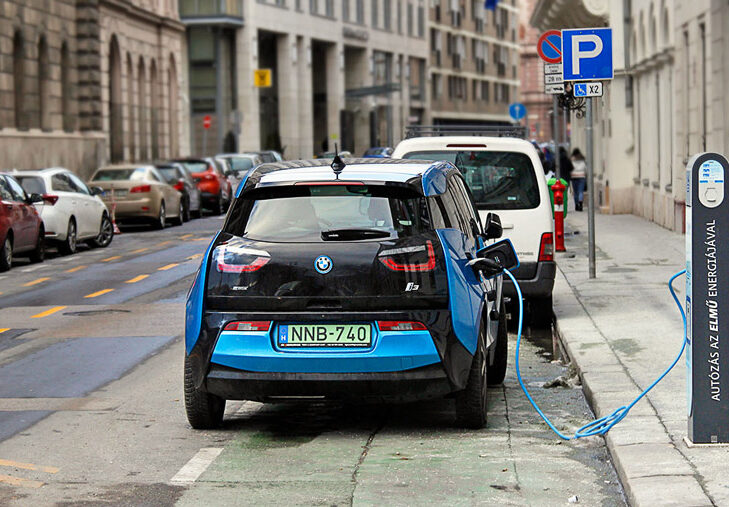
Lack of infrastructure a fundamental issue in the growth of electric vehicles
Carbon dioxide (CO2) emissions from newly registered passenger vehicles are meant to be falling. The European Union (EU) fleet-wide average emission target of 95g CO2/km comes into effect in 2021, and the EU Parliament and Council have already turned their attention to the next phase of CO2 regulations for new passenger cars and light commercial vehicles. On 17 April 2019, the lawmakers passed Regulation (EU) 2019/631, imposing a reduction in tailpipe CO2 emissions from new passenger cars of 15 % in 2025 and 37.5% in 2030.
Despite these stringent, but necessary, targets, CO2 emissions of new passenger cars in Europe have increased in both 2017 (+0.3%) and 2018 (+1.8%) — the first increases in CO2 emissions from new cars since records began. EU-wide, average emissions currently sit at 120.6g CO2/km, a far cry away from the looming emissions target. The Netherlands has the lowest emissions in Europe (105.5g CO2/km), while Estonia trails the field with average CO2 emissions of 132.3g CO2/km. At the heart of this worrying trend is a surge in the demand for petrol-powered vehicles.
The European Automobile Manufacturers’ Association (ACEA) recently released its first annual report on progress towards transport CO2 targets and the uptake of alternatively powered cars in the EU. The report, “Making the transition to zero-emission mobility 2019 – enabling factors for alternatively-powered cars in the EU” was published in September 2019 and will provide a “factual, data-driven picture of progress” in the lead up to the mid-term review of 2019/631 regulation in 2023.
 Released at the Frankfurt Motor show, the ACEA report highlighted a 1.2 million unit drop in annual diesel car sales from 2014 to 2018. In 2017, petrol vehicles overtook diesel cars as the most sold car type for the first time since 2009. Despite their drawbacks, diesel cars emit lower CO2 volumes than equivalent petrol vehicles. A 2019 report by the European Environment Agency estimates new conventional petrol cars emit 10-40% more CO2 than new conventional diesel cars.
Released at the Frankfurt Motor show, the ACEA report highlighted a 1.2 million unit drop in annual diesel car sales from 2014 to 2018. In 2017, petrol vehicles overtook diesel cars as the most sold car type for the first time since 2009. Despite their drawbacks, diesel cars emit lower CO2 volumes than equivalent petrol vehicles. A 2019 report by the European Environment Agency estimates new conventional petrol cars emit 10-40% more CO2 than new conventional diesel cars.
Electric or alternatively powered vehicles are often hailed as the earth’s environmental saviour. The reality is consumers are not yet voting with their wallets and alternatively powered vehicle sales are not increasing fast enough. The technology requires a significant boost if the EU has any chance of achieving the ambitious new CO2 targets over the next decade. For now, market penetration is low and infrastructure is fragmented across Europe.
The ACEA report states that 2.0% of new car sales in 2018 were electrically chargeable and 3.8% were hybrid electric. A meagre 0.2% of all passenger cars on EU roads are electrically chargeable, whereas hybrid electric vehicles contribute 0.6% of all cars. Natural gas-powered cars accounted for only 0.4% of all new car sales, and fuel cell vehicles sales are “negligible.” Only four European countries have a market share for electrically chargeable vehicles of over 2.5%. Almost three-quarters (74%) of natural gas vehicle sales are concentrated in just two countries — Italy and Germany.
European auto manufacturers are beginning to expand their portfolios of such vehicles. However, the ACEA report pinpoints a lack of infrastructure as a fundamental issue in the continued growth of electric vehicles (EV). Battery electric vehicles (BEVs) and Plug-in hybrids (PHEVs) both possess onboard batteries that require connection to the electricity grid for charging.
There are approximately 144,000 charging points across Europe. ACEA advises that these volumes “fall far short of what is required.” Estimates from the European Commission require at least 2.8 million EV charging points by 2030.
Equally influential is the distribution of charging infrastructure. The ACEA report indicates over three-quarters of charging points are in just four countries, the Netherlands (25.8%), Germany (19.1%), France (17.3%) and the United Kingdom (13.3%). Notably, these four nations only account for 27% of the EU surface area.
Natural gas filling stations are similarly imbalanced in their distribution. Of the 3,400 natural gas filling stations in the EU, 63% of CNG and LNG filling stations are in Italy and Germany. Cyprus, Ireland, Latvia and Malta do not possess a single natural gas filling option. In addition, only 47 hydrogen filling stations exist throughout Europe.
ACEA is calling for governments across the EU to ramp up investments in charging and refuelling infrastructure to match the increasing pace at which automakers are releasing new technology. The report cites a clear link between the market uptake of electric vehicles and the number of charging points per 100km.
 Certainly, charging needs to be far more convenient in order to encourage the uptake of electric vehicles. However, investments in charging and fuelling infrastructure are not without risk. Tim Johnson, executive consultant for Corning Environmental Technologies, suggests charging stations are difficult to justify economically with low utilisation rates and high capital cost, and refuelling is expensive unless it is heavily subsidized. While faster charging is emerging, charging is presently very onerous, and “probably has to be nearly as convenient as gasoline for the 50% without home or work charging,” says Johnson.
Certainly, charging needs to be far more convenient in order to encourage the uptake of electric vehicles. However, investments in charging and fuelling infrastructure are not without risk. Tim Johnson, executive consultant for Corning Environmental Technologies, suggests charging stations are difficult to justify economically with low utilisation rates and high capital cost, and refuelling is expensive unless it is heavily subsidized. While faster charging is emerging, charging is presently very onerous, and “probably has to be nearly as convenient as gasoline for the 50% without home or work charging,” says Johnson.
Speaking at the 2019 JSAE/SAE Powertrains, Fuels and Lubricants International Meeting on 29 August 2019, Johnson cited a University of California, Davis, study (by Gil Tal, et. al), that only 3% of BEV owners in the U.S. charge exclusively at public charging stations, while 10-15% use public charging on occasion. Half of BEV owners charge exclusively at home, and a further 16% charge only at work.
Operating costs of charging stations are also comparatively high, says Johnson, with maintenance and site rental key cost drivers. Solid-state transformers may provide one possible solution. The technology has a much smaller footprint and modularity to allow for expansion. Citing a PS Automotive GmbH study, Johnson said charge stations will need to charge EUR0.66(USD0.72)/kWh to be profitable in 2025.
Nevertheless, economics and technologies are changing. But it is your classic chicken and egg situation. What comes first — investment to allow for future market expansion, or should governments wait until the technology is more clearly defined? In 2025, the share of new BEV registrations is projected at 24%, which will deliver higher charging station utilisation.
Lack of EV infrastructure is a global problem. China is the world’s largest market for EV by volume. Despite 275,000 public and 1.5 million private chargers, the region also has major issues with range anxiety — the concern that the battery will run out of power before a suitable charging point is reached. Large populations in China live in high rises and lack dedicated parking spots for home charging. Expansion of China’s public charging network is critical to the country’s continued dominance. The National Development and Reform Commission estimates China requires 500,000 public chargers, alongside 4.3 million private chargers, by 2020.
While electric carmakers search for the next big battery breakthrough that will minimise charging frequency, new technology may hold the key to global infrastructure requirements. Work is already underway on dynamic wireless charging, where chargers are embedded into the surface of the road and enable a power exchange between the vehicle and the grid — while the vehicle is in motion. The technology may provide the ability to extend an EVs range in a typical urban environment.







